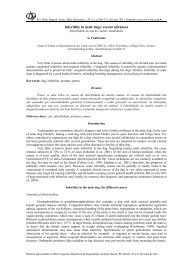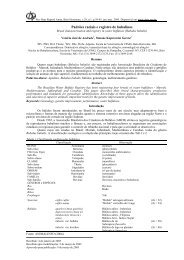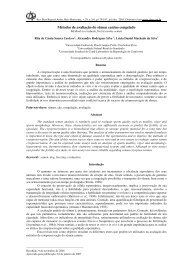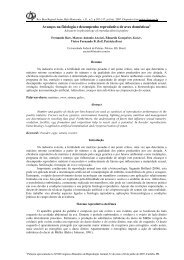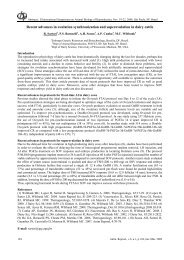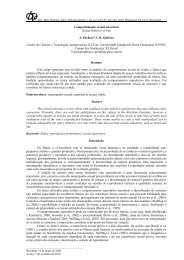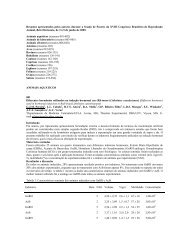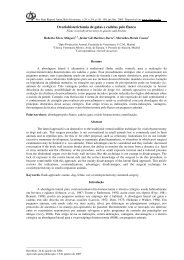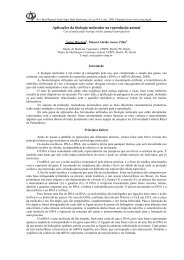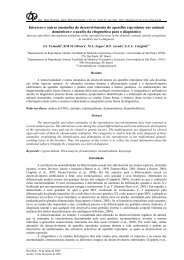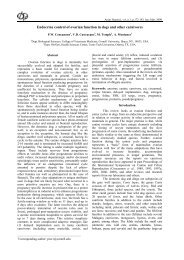Sanitary requirements for bovine gametes and embryos in ... - CBRA
Sanitary requirements for bovine gametes and embryos in ... - CBRA
Sanitary requirements for bovine gametes and embryos in ... - CBRA
You also want an ePaper? Increase the reach of your titles
YUMPU automatically turns print PDFs into web optimized ePapers that Google loves.
Ponsart <strong>and</strong> Pozzi. <strong>Sanitary</strong> <strong>requirements</strong> <strong>for</strong> <strong>gametes</strong> <strong>and</strong> <strong>embryos</strong>.Technical staff <strong>and</strong> animal managementAs mentioned <strong>in</strong> the OIE Animal Health Code,the laboratory personnel should be technically competent<strong>and</strong> observe high st<strong>and</strong>ards of personal hygiene topreclude the <strong>in</strong>troduction of pathogenic organisms dur<strong>in</strong>gsemen evaluation, process<strong>in</strong>g, <strong>and</strong> storage. In CSS(2011b; AI center animal management guidel<strong>in</strong>es),complete recommendations <strong>for</strong> animal management, sire<strong>and</strong> hygiene procedures, feed<strong>in</strong>g <strong>and</strong> hous<strong>in</strong>g conditions<strong>and</strong> veter<strong>in</strong>ary <strong>and</strong> professional care are described.Specific sanitary <strong>requirements</strong> <strong>for</strong> <strong>bov<strong>in</strong>e</strong> semenIn general terms, microorganisms can be present<strong>in</strong> the semen of an <strong>in</strong>fected male or can ga<strong>in</strong> entry to semendur<strong>in</strong>g collection, process<strong>in</strong>g, or storage. In order toma<strong>in</strong>ta<strong>in</strong> a controlled status of semen batches, tests must beapplied on semen <strong>and</strong> genital tract, semen production, <strong>and</strong>sanitary control of the bulls present <strong>in</strong> the center.For given pathogenic agents, semen can becertified as free if the donor bull orig<strong>in</strong>ated from a freeherd, the dam of the bull is free, the donor bull is free,the donor bull is <strong>in</strong>troduced to a center where all otherbulls are free, <strong>and</strong> all the bulls present <strong>in</strong> the center aresubmitted to regular tests regard<strong>in</strong>g this agent. For eachagent, specific OIE <strong>requirements</strong> aim to ma<strong>in</strong>ta<strong>in</strong> thehealth of animals on an artificial <strong>in</strong>sem<strong>in</strong>ation center ata level which permits the <strong>in</strong>ternational distribution ofsemen with a negligible risk of <strong>in</strong>fect<strong>in</strong>g other animalsor humans with pathogens transmissible by semen, asdescribed <strong>in</strong> the Table 4.<strong>Sanitary</strong> <strong>requirements</strong> <strong>for</strong> <strong>embryos</strong> used <strong>in</strong><strong>in</strong>ternational tradeAlthough transfer of <strong>bov<strong>in</strong>e</strong> <strong>embryos</strong> is muchless likely to result <strong>in</strong> disease transmission than transport oflive animals (Thibier <strong>and</strong> Wrathall, 2012), the sanitary riskassociated with <strong>bov<strong>in</strong>e</strong> embryo transfer rema<strong>in</strong>s the subjectof scientific <strong>in</strong>vestigations (Van Soom et al., 2008) <strong>and</strong>adaptations of national <strong>and</strong> <strong>in</strong>ternational legislations (OIE,2012; Chapters 4.7 <strong>and</strong> 4.8).Physiological backgroundInteraction of oocytes <strong>and</strong> <strong>embryos</strong> withpathogenic agents has been extensively reviewed byBielanski (2006). Oocytes <strong>and</strong> early embryo stages up toapproximately day 8 after fertilization, are surrounded byan acellular glycoprote<strong>in</strong> shell with a sponge-like surface,the zona pellucida (ZP). Visualized by scann<strong>in</strong>g electronmicroscopy, the ZP is composed of a fibrous networkwith numerous pores. The pores are larger at the outersurface (outer diameter of <strong>embryos</strong> range from 155 to223 µm <strong>for</strong> different embryonic developmental stages)but decrease <strong>in</strong> size centripetally <strong>in</strong> both animals <strong>and</strong>human <strong>embryos</strong> (Bielanski, 2006). Such anatomicalstructures of the ZP allows <strong>for</strong> adhesion of pathogens, butprevents them from fully penetrat<strong>in</strong>g the ZP.S<strong>in</strong>ce the ZP is acellular <strong>in</strong> character, viruses arenot able to replicate there <strong>and</strong> they must cross the ZP <strong>and</strong>the cell plasma membrane to <strong>in</strong>fect an embryo. In general,ova or <strong>embryos</strong> can become contam<strong>in</strong>ated at differentstages: be<strong>for</strong>e the ZP is <strong>for</strong>med (under physiologicalconditions, the ZP is <strong>for</strong>med <strong>in</strong> the ovarian preantralsecondary follicles), later by agents present <strong>in</strong> thefollicular fluid, by pathogen-contam<strong>in</strong>ated semen dur<strong>in</strong>gfertilization or dur<strong>in</strong>g passage through the oviduct <strong>and</strong> theuterus, even if <strong>in</strong>tegrity of the ZP prevents contam<strong>in</strong>ationof embryonic cells <strong>for</strong> most pathogens (Bielanski, 2006;Van Soom et al., 2008). With the application of <strong>in</strong> vitrofertilization techniques, immature oocytes surrounded bya multilayer of compacted granulosa cells (cumulusoocytecomplexes) are collected from ovarian folliclesus<strong>in</strong>g Ovum Pick Up (OPU) or from slaughterhousederived ovaries <strong>and</strong> placed <strong>in</strong> the maturation medium.Dur<strong>in</strong>g this period, the granulosa cells become exp<strong>and</strong>ed<strong>and</strong> their connections with the ZP loosen. Later, thegranulosa cells are mechanically removed, delet<strong>in</strong>g theconnection between these cells <strong>and</strong> the ZP. Specific risksare l<strong>in</strong>ked to artificial culture conditions, rather than theutero-tubal environment which occurs with <strong>in</strong> vivofertilization (Bielanski, 2006).Requirements applied to <strong>in</strong> vivo derived <strong>embryos</strong>Assessment of disease transmission via <strong>in</strong> vivoderived <strong>embryos</strong>Experience <strong>and</strong> experimental evidence has<strong>in</strong>dicated a low potential <strong>for</strong> transmission of <strong>in</strong>fectiouspathogens via <strong>in</strong> vivo-derived (IVD) <strong>embryos</strong> (Givens etal., 2007; Thibier 2011). Pathogens may be shed <strong>in</strong>to thegenital tract <strong>and</strong> contam<strong>in</strong>ate the surface of <strong>embryos</strong>, ifthose pathogens are present at the time of collection orbetween fertilization <strong>and</strong> collection. Scientific reflectionson the sanitary risks associated with ET have focused onthe probability that <strong>embryos</strong> can be contam<strong>in</strong>ated either viathe oocyte, the semen, or adhesion to the zona pellucida.There have been many <strong>in</strong>vestigations to evaluate<strong>in</strong>teractions between pathogens <strong>and</strong> <strong>embryos</strong>, us<strong>in</strong>gdifferent <strong>in</strong> vivo or <strong>in</strong> vitro <strong>in</strong>fection approaches (Table 5).In vivo approaches are the most suitable toevaluate the likelihood of transmission through embryotransfer, however such experiments require expensiveprotocols <strong>in</strong> order to <strong>in</strong>fect donor animals <strong>and</strong> per<strong>for</strong>msubsequent transfer to recipients. As an example, facilitieswith a controlled environment <strong>and</strong> that are <strong>in</strong>sect-proof arerequired to <strong>in</strong>vestigate vector transmitted diseases. Fordiseases with a long <strong>in</strong>cubation period (e.g., prions),experiments may last several years. Complementary <strong>in</strong>vitro approaches can be used to ga<strong>in</strong> knowledge withmore accessible costs (Table 5). Indeed, <strong>in</strong> vitroexperiments are ultimately more conservative <strong>and</strong> arenot as likely to be <strong>in</strong>fluenced by factors like m<strong>in</strong>imum<strong>in</strong>fective dose, <strong>in</strong>nate immunity etc. Realistically, if an <strong>in</strong>vitro experiment does not reveal the presence of <strong>in</strong>fectiousagents, the likelihood of an <strong>in</strong> vivo experiment show<strong>in</strong>g itspresence is very unlikely.Anim. Reprod., v.10, n.3, p.283-296, Jul./Sept. 2013 287



